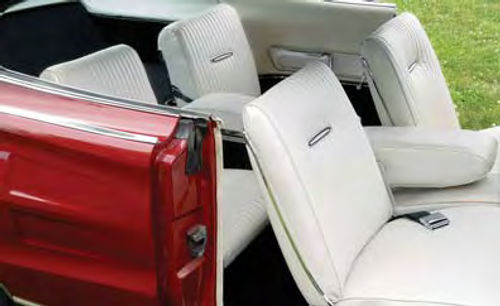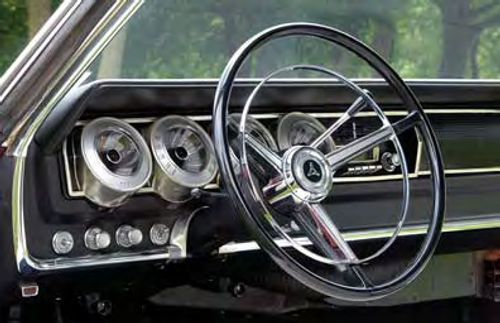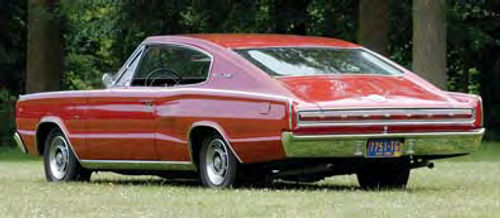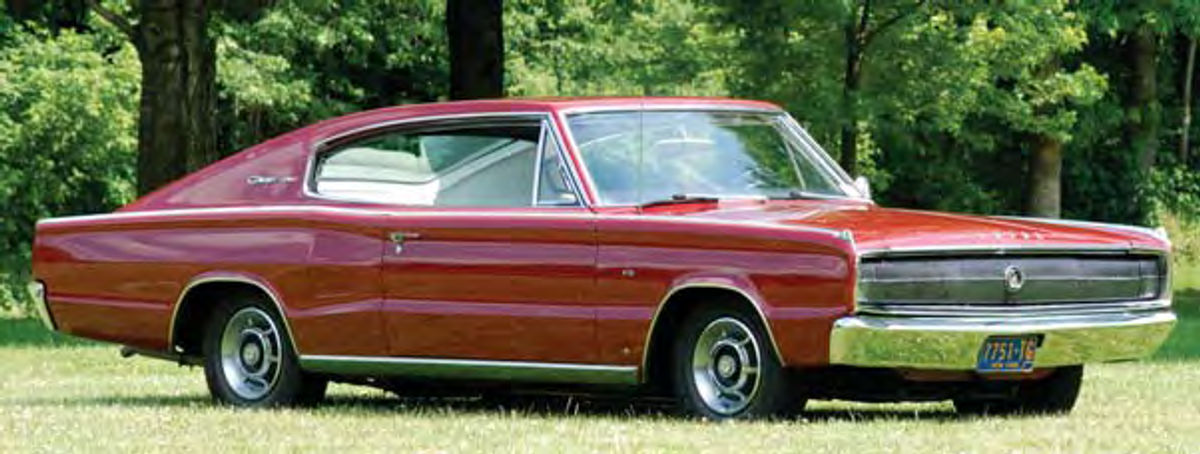1967 Dodge Charger

This Dodge Originally Belonged to an Older Vermont Woman… And All Along We Thought She Was From Pasadena.
IF A FRIEND had a car that you really liked and then he gave it to you, deciding to accept it would be easy. That it was a low-mileage example that had beaten the odds would be a bonus. And while that kind of survival is sometimes inexplicable, Bill France has a pretty good idea how his 1967 Dodge Charger managed to make it in a region that often consumes cars.
“It was brought down here from Vermont in the mid-1970s,” France said. “I got the car in the early ’80s.”
When he says “here,” he means Binghamton, New York. It’s an area where winter road conditions inflict serious rust, a statement that applies about equally to Rutland, Vermont, where the car’s original owner purchased it for his wife. From there, the story takes some odd turns.
It Was Only Driven…
“The original owner was 75 years old when he bought it for his wife from that dealer in Rutland,” France said. “He died, I think, three years later. You know the story that it was only driven to the store and you could see the store from the house, well, you could. You could see the store from her house.”
A Charger with a 383 probably wasn’t the typical car for an older Vermont woman making very short trips to the store. But since her son was a pilot, he’d fly from Binghamton to Vermont to see her and use the Charger while he was there. After she died, he drove it to Binghamton and by then, it had accumulated just 6000 miles.
“He drove it another 4000 while he had it here,” France said. “He was a great golfer and that car’s got that big trunk. So after he retired, he’d throw his golf clubs in it, take it golfing all over the area. We’d go to supper a lot with them and we’d always take the Charger because he knew I liked that car.
“So it was driven another 4000 miles and then they gave the car to me. I drove it 1000 miles before I took it off the road.”
Thus, the Charger had covered only 11,000 miles in close to two decades as a transportation car. That was in the mid1980s and by then, it wasn’t perfect.
“The paint was shot,” France recalled. “It wasn’t like the floors were gone, but there was rust on it. The car was driven in Vermont in the wintertime. The engine compartment was filthy and like I said, the paint was bad. It had holes in each front fender, had some minor holes in the quarter panel on the right-hand side.”
A Father-and-Son Project
While it was garaged, France began the bodywork and removed the bumpers and trim, but he didn’t get very far before medical problems brought the project to a stop. That was when his son, Kevin, entered the picture.
“I was a mechanic for over 20 years,” France said, “so I had tons of tools. We took everything down to Kevin’s garage…and drove the car down in February of 2004. A year-and-a-half later, we were pulling it out of the garage and that’s what you see.”
Or maybe it wasn’t quite as simple as that sounds.
“Like Dad said, he had his health problems and it kind of scared us a little bit,” Kevin explained. “He and I had talked in the past about sending it out to have it restored and getting it to look good. Then I bought this house and it had a nice garage.
“We brought the car down there and the first intentions were to do whatever we could to save money at the body shop. It took two years, but as a hobby, I’d go out and work on it when I could and everything just kind of fell together. It was primed and sanded and ready for painting and I figured, ‘what the hell, let’s paint it. What’s the worst that could happen? We’d have to sand the paint off it and send it out and get it painted.’”
He started with the engine compartment and admitted that he surprised himself with the result. Next came the doorjambs and the trunk with equal success, so it was on to the exterior finish.
“I’m not blowing my own horn by any means,” Kevin said, “but I’d never restored a car before. Never. This was my first car. I drove Dad nuts because I’m pretty obsessive about it. There were several times when he came over and thought the car was ready to be painted and then the next time he’d come over, I’d have been sanding and grinding, but it’s done and it came out well.”
And maybe that wasn’t quite as simple as it sounds; the Charger had some of the rust problems common to Mopars of the time, but not to an extent as serious as might be expected on a car from the Northeast. The fenders, Kevin said, had minor holes above the wheel wells while the heels were bad enough that new sections were welded into place.
“The rockers are solid,” Kevin said, “not a bit of a problem with the rockers. The front lower part of the quarter between the door and the wheel well on the passenger side, that was pretty bad.”
The Charger had spent some time parked in his father’s driveway and although the asphalt surface probably protected it somewhat, the adjacent brush might have kept that side of the car from completely drying. The long piece of stainless steel trim along each rocker had trapped moisture at several points that then rusted, Kevin said, and there were other problems that needed attention.
“Dings, dents, it had a big dent on the driver’s side behind the door,” he said. “Something had hit it and that was probably the biggest dent.” That just about covers the worst of the bad news.
The Charger’s bumpers needed to be replated, but were free of dents and rust, while its pot metal grille is undamaged and the original motors on the hidden headlights continue to function perfectly. The original spark plug wires were replaced because they had become brittle and since they are the originals, Kevin still has them.


“All the brake linings and wheel cylinders are still all original,” Bill said. “It still has the original points, rotor, condenser and distributor cap on it. The original Goodyear spare tire is still in the car. The jack has never been taken out of the trunk.”
“That’s one thing about the car that was surprisingly mint,” Kevin said, “the trunk floor. I’ve seen on eBay and in salvage yards that on ’66 and ’67 Chargers, the trunk floors are usually gone. It’s got that big area down where the spare tire goes and I guess that’s prone to filling with water, but this trunk’s perfect. In fact, I didn’t even paint the trunk floor.”
The 22-Piece Carpet Job
The interior didn’t hold up quite as well. Sun damage to the front seats was extensive enough to require that they be recovered and earlier this year, the factory carpet was replaced. Kevin said that work was less difficult than time-consuming and offered a critical piece of advice.
“If you ever get the opportunity to change the carpet in a ’66 or ’67 Charger,” he warned, “say ‘no.’”
“Don’t do it,” Bill added. “There are twenty-two pieces of carpet in that car. We had to pull the interior out of it.”
The two-day project was a nightmare, they agreed.
“So many pieces,” Kevin explained, “and you’ve got the console in the back that the carpet has to wrap around and glue. Almost every piece, with the exception of the two floor mats, had to be glued.”
“The door panels and even the backs of the seats have carpeting,” Bill said. “There are 23 pieces if you count the trunk, but we didn’t replace the trunk and that’s still original. That would’ve been the easiest one to replace.”
Work on the interior led to discovery of two factory build sheets, one under the rear seat and the other above the glovebox. A Charger-owner might find the latter when he’s dealing with the car’s electroluminescent gauges, an interesting and very different system that Chrysler introduced in 1960.
The oversimplified explanation is that instead of the conventional 12-volt incandescent bulbs that light most automotive gauges, the needles and the faces of the gauges give off their own light when charged with several hundred volts of alternating current.
Developed with Sylvania, long life and durability were among its claimed benefits, but it’s hardly fair to complain if it lasted only a few decades as on the feature car
1967 Dodge Charger
GENERAL
Front-engine, rear-drive, two-door fastback
ENGINE
Type Overhead-valve V-8
Bore x stroke 4.25 in. x 3.38 in.
Displacement 383 cu. in.
Compression ratio 9.2:1
Carburetor Two-barrel
Power 270 hp at 4400 rpm
Torque 390 lb.-ft. at 2800 rpm
DRIVETRAIN
Transmission Three-speed automatic
Rear end Hypoid
SUSPENSION & BRAKES
Front Independent, torsion bars
Rear Live axle, leaf springs
Brakes (f/r) Drum/drum, power assisted
MEASUREMENTS
Wheelbase 117 in.
Length 203 in.
Width 76 in.
Height 54.5 in.
Track (f/r) 59.5/58.5 in.
Weight 3480 lb.
Fuel capacity 19 gal.
Tire size 7.75 x 14
“The dash lights in these things are a nightmare,” Bill said. “When you take the dash out, you take the outside panel off and you have your instruments in the cluster. On those gauges, there’s stuff that looks just like putty. It’s gray and it has a really fine copper wire about the size of a hair that comes up through that metal instrument panel and goes into this putty. The needles have really fine wires coming up to them and they’re wrapped with a red material. Up underneath the dashboard, in the center of the dashboard, there’s a converter that takes 12-volt DC and converts it to AC.
“That makes this stuff glow and they’re pretty at night, but if anybody’s working on them, they want to make sure they’re protected because if you’re not, it’ll knock you right out of the car.”
Beyond the possibility of injury, there’s also the chance of damaging the system through a lack of familiarity with it. Despite his having worked at a Chrysler Plymouth dealership in the 1960s and 1970s, Bill had no experience with it and was unable to find information until he got the details from another owner who had already been through it.
A Mainly Original Example
Today, the Charger’s dashboard is illuminated as Chrysler and Sylvania intended; the glowing gauges are slightly eerie, but beautifully efficient and as easy on the eyes as Chrysler promised. They do, however, serve as a good example of what restorers will face as cars become more and more complex. In the feature car, they’re original in that the speedometer was repaired, but not replaced. All of the interior trim is original, too, as is much of the exterior brightwork.
“The only things that I’ve replaced are the moldings around the headlights and around the taillights,” Bill said, “the two door handles and the outside mirror. Everything else is still original on the car.”
Less surprising is how little work the engine required.
With just 17,000 miles on the car, it’s hard to think of an internal engine component that could be worn out, but checking seemed like a good idea and a few replacements were made just to be on the safe side.
“The only thing we did was take the oil pan off and take the valve covers off,” Bill said. “It still had the green paint on the valve springs. The inside of the engine was just as clean as can be. But I wanted to look.
“We changed the fuel pump, because how long will that rubber last? And we changed the water pump because I was worried about that seal once we started driving it.”
Concern over the effect of driving also prompted some work on the suspension.
“When we got it over to Kevin’s garage and we jacked it up,” Bill recalled, “the upper control arms came down against those rubber bumpers and (the bumpers) went in four pieces. I told Kevin right there ‘we’ve got to take the suspension out. We’ve got to replace those bushings.’ They were all hard and cracked, so we did replace all the bushings in the front end. The steering’s all original, the power steering pump and the box.”
However, several other component replacements were made because Bill wanted to make them.
“The only major changes we made on it were that it was a 383 two-barrel with single exhaust and I had dual exhausts put on it,” he explained, “and it took me over two years, but I found an original ’67 AFB carburetor in California. Had it been ordered from the factory with a four-barrel, that’s the carburetor that would’ve been on it. The same with the air cleaner. That’s the air cleaner that would’ve come with it in ’67.”
What if he someday decides to become an ultra purist?
“I’ve got the original manifold,” Bill said, “and the two-barrel carburetor.”
First Off, Put It on a Lift
Not surprisingly, Bill’s first piece of advice to a restorer considering a Charger has a lot to do with where he lives.
“I’d definitely take it someplace and get it up on a lift,” he said. “In this part of the country, you’ve got to check underneath them. These cars were noted for the rear springs coming up into the trunk.”
Some Uncommon Rust Problems
Even staunch Mopar fans will concede that a Charger from someplace other than the Southwest is likely to have rusted much more seriously than has the feature car, as the mid-1960s were not the golden years of rust-resistance among American vehicles. Many of the problem areas are almost universal or at least easily detected.
Floors in both the passenger compartment and the trunk are always worth a close inspection, as are inner and outer rocker panels. On the Charger, the latter is key because of the large trim piece running the rocker’s length. Even the beginnings of rust at the wheel wells and at the tops and heels of the fenders should be simple to spot, as should problems with the quarter panels. But beyond those, some known problem areas might be unexpected among those who don’t know Chargers.
“You want to check where your hood hinges mount,” Kevin said. “Between the inner fender panel and the firewall and where your hood hinges are, a lot of them are rusted right through.”
“It’s part of the inner fender that the hood hinge is hooked to,” Bill added. “You just have to look at all of your unibody structure and subframe. You have to look that stuff over really close.”
“Another spot they rusted is below the rear window,” Kevin said. “The water puddles in there and you’ll get holes. This car didn’t have that.”
If there’s a trick to use when inspecting a Charger, it’s the universal trick of deep research and looking at as many examples as possible. There’s a lot to be said for knowledge and experience, even if the payoff isn’t always instant.
“I worked for a Chrysler dealer from 1966 to 1973, back in the performance years, and I had forgotten what nice road cars these things are,” Bill said. “It’s just terrific on the highway. A 383, plenty of power, just terrific.
“(But) it’s a little hard to get used to. We have a PT Cruiser and the rack-and pinion steering compared to that full-time power steering, that takes a little bit of getting used to, but it’s just a terrific car to drive. I’d drive that car anyplace.”
And why not? The complaints that can be leveled against the Charger aren’t exactly major ones; driving it is roughly comparable to driving most of its contemporaries in that everything requires too little effort. Granted that Chrysler probably carried that approach further than the competition did, nearly any car of that era demands that a driver in 2008 make some adjustments.

The Brakes Are Quick & the Steering’s Light
I drove slightly later Plymouth intermediates back in the early 1970s and therefore knew what to expect.
I was prepared for the brakes that will stop the Charger impressively quickly, but only after I’d determined by testing just how smoothly to step on the pedal. A moderately hard stop—not a panic stop—was straight and not at all difficult to control, something I credit mostly to the car and somewhat to the fact that I remembered how touchy those brakes were; that’s why I had chosen to try them a few times before I really needed them for anything spectacular.
The Charger went where I pointed it in that hard stop and while that’s expected of cars today, it’s noteworthy when the car is 41 years old. All it took was a very small amount of steering-correction, the kind that doesn’t even interrupt conversation, and I’ll split the credit with the car on that, too.
What’s impossible to dispute, though, is that the Charger feels nothing like a 2008 car. Anyone whose driving experience is limited to vehicles of the past 15 or 20 years could be in for an eye-opening ride behind its wheel; the brakes will halt it painfully quickly if not applied with thought and the steering offers almost no resistance. The Charger could get an inexperienced or overconfident driver into serious trouble, but it’s waiting to reward anyone who puts some effort into figuring it out.

We were in fairly heavy stop-and-go traffic on a four-lane highway—which was where some of the practice with the brakes came in—and the waiting time was an opportunity to experiment with getting comfortable. The steering wheel is at just the right angle and just the right point on the dashboard, so that didn’t require any adapting. I’d adjusted the seat for maximum legroom as soon as I’d gotten in and that was fine, but my height created a problem. The seat provides good back support and the bottom cushion is shaped to keep the driver from sliding around, but it’s too short in the front-to-back dimension to support the right leg. I know from experience with other similarly afflicted cars that after an hour or so, that hurts, but I’m sure that it wouldn’t bother a driver of average height.
Short or tall, though, nearly any driver would like the visibility from the Charger. True, it’s hard to overlook those giant sail panels, but the large side-windows make the car feel open and even the view through the backlight is better than what some other fastbacks offer.
Standing Out In the Crowd
There’s also the other kind of visibility to consider. After the road dropped to two lanes, the Charger got up to an immoderate speed very quickly and sounded great as it did so, but nearly any car would stand out while putting on that kind of display. What’s more interesting is that back on the slow-going four-lane, we hadn’t even been close to avoiding detection. As we crawled along between stops at closely spaced traffic lights, drivers and passengers in nearly every other car were watching us.
At least some of that is due to the fact that most drivers don’t see a first-generation Charger on the road every day and it really doesn’t look like much else. The other point, though, is that the car looks as good as it does thanks to the care that went into its restoration.
That level of attention wasn’t limited to the finish; driving the Charger on a temporary surface in a roadwork area proved that putting the necessary effort into the suspension can eliminate squeaks, rattles and bounces.
The finest work possible, though, can’t change the fact that in today’s world, the Charger feels like a very big car.
“Drive this into a construction zone where it’s all coned off,” Bill laughed. “It really doesn’t look like you’re going to have room to get through.”
















